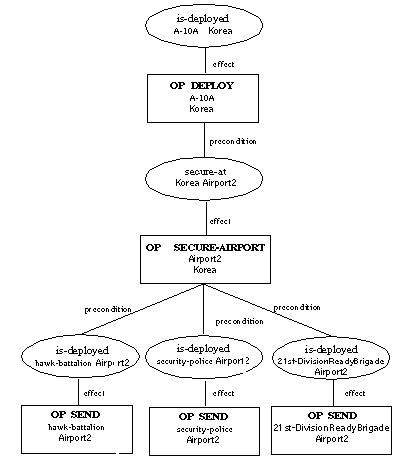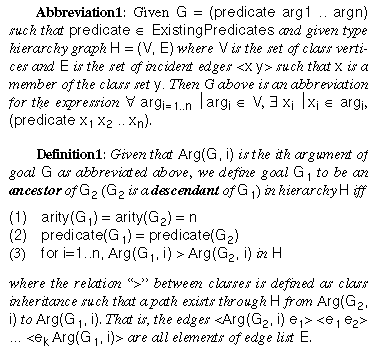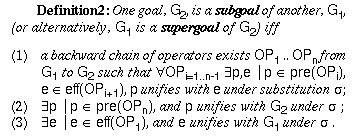 Postscript Version
Postscript Versionmcox;mmv}@cs.cmu.edu
Abstract In a mixed-initiative setting where both human and machine are intimately involved in the planning process, a number of challenges exist for traditional planning frameworks. In this paper we will examine the types of unexpected goals that may be given to the underlying planning system and thereby how humans change the way planning must be performed. Users may want to achieve goals in terms of actions as well as states, they may specify goals that vary along a dimension of abstraction and specificity, and they may mix both top-level goals and subgoals when describing what they want a plan to do. We show how the Prodigy planning system has met these challenges when integrated with a force deployment tool called ForMAT and describe what opportunities this poses for a generative planning framework.
 Postscript Version
Postscript VersionSimply obtaining input from the user can prove to be a challenge. Normally the goals given to a planning system by a knowledgeable and sympathetic user are in a well-structured format. But goals provided by an unrestrained user present at least three problems to traditional planning systems: (1) input goals may actually be specified as actions rather than states; (2) they may be abstract rather than grounded; and (3) they may include subgoals along with top-level goals. This paper will describe the control exerted by the planner to manage such problems. The second section will introduce the mixed-initiative planning system from which we extrapolate our experience. The subsequent sections describe the three problems encountered and our solutions. The paper concludes with a brief discussion.
Prodigy/Analogy is a fully-automated planner that combines generative and case-based planning. Based on defined planning actions (operators), it creates plans, interprets and stores planning episodes, and retrieves and reuses multiple past plans that are found similar to new problems. Stored plans are annotated with plan rationale, and reuse involves adaptation driven by the plan rationale. Research to integrate Prodigy/Analogy and ForMAT has investigated sophisticated methods for providing plan modification guidance to the ForMAT user. Guidance from Prodigy suggests to the user how to modify the elements of a past plan to fit the current situation. The sequence of events is as follows.
A ForMAT user receives the description of a new mission. Selecting attributes from the mission description to serve as probes into memory, the user queries ForMAT's database of past plans in search of relevant exemplars with which to build a plan. While browsing, the user refines the mission statement in terms of specific objectives (i.e., goals to be achieved) utilizing a domain-specific goal language. Using past plans as a template, the user edits the old case, substituting new features and values for old, deleting irrelevant old plan steps, and adding necessary new ones. As plan construction proceeds, the user can perform consistency checks on specific aspects of the plan to ensure plan integrity. During these actions, ForMAT sends messages to Prodigy/Analogy, capturing the history of the user actions.
When the mission goals are entered by the user, ForMAT reports this information to Prodigy/Analogy. Given the mission goals, Prodigy retrieves similar past solutions from its own database of plans (a mirror of the ForMAT database in a state-space representation) or creates a new plan generatively given an empty retrieval. It then identifies useful modifications for the past plans as a function of the new and past missions' rationale. Suggestions are sent to the ForMAT user that specify relevant past plans, additional retrieval probes, and potential modifications that the user should perform when building the plan.
A ForMAT user is given a planning problem in the form of a commander's mission statement. This statement is a description of a military objective along with guidance towards its achievement.
The ForMAT user represents these statements in the system's goal editor. The goals specify the military planning objectives and may or may not bear close resemblance to the kind of goals Prodigy expects. When the user saves the goals from the editor, the goals are automatically sent to Prodigy in the representation shown by Figure 1.
(:GOALS
(g-146 :SEND-SECURITY-POLICE
(GEOGRAPHIC-LOCATION KOREA)) )
(g-145 :SEND-BRIGADE
( (FORCE 21ST-DIVISIONREADYBRIGADE)
(GEOGRAPHIC-LOCATION KOREA)) )
(g-144 :SEND-HAWK
( (FORCE HAWK-BATTALION)
(GEOGRAPHIC-LOCATION KOREA)) )
(g-143 :DEPLOY-A10A
( (GEOGRAPHIC-LOCATION KOREA)
(AIRCRAFT-TYPE A-10A)) ) )

Figure 2. Prodigy goal tree
The preprocessor simply parses each ForMAT goal and obtains the corresponding Prodigy operator from a table. The primary effect of such operators then become the translated goal. To some extent, this solution finesses the more general problem of understanding user intent and desire (Pollack, 1990). For example, the translation heuristic assumes that the user does not wish the action to be accomplished due to a side-effect the operator can produce. However, for the purposes of the integration experiment and within the limited domain for which it is used, this solution proves sufficient.
A larger open question exists as to whether humans plan better in terms of actions or states (cf., McDermott, 1978). Some hierarchical planners support task level specification of goals. See, for example, Wilkins & Desimone (1994) for an application of hierarchical planning in a mixed-initiative setting for military operations planning. Nevertheless, in the military domain, the key notion of objective is important in high level planning, and this concept is often cast in terms of state. In either case, an automated planning component should allow humans to express goals in natural and familiar terms consistent with their language of manual planning.
However given a hierarchy of types, a difficulty is that different operators may apply to goals up and down the abstraction hierarchy. For instance, the operator SECURE-AIRPORT is used to make secure a specific airport (see Figure 3); whereas a more general SECURE operator is used to make secure objects such as hills for which no specialized operators exist. The difference between the two is that the second operator does not have an <air-defense> variable (nor the precondition associated with it) and the variable <obj> is of type OBJECT, rather than a more specific type AIRPORT (and thus the effect and preconditions are more abstract).[1] The first operator can be used to achieve (secure-at Korea Airport2), while the second is appropriate when achieving either a literal such as (secure-at Korea Hill21) or an existentially quantified goal such as (exists ((<obj> OBJECT)) (secure-at Korea <obj>)).
(OPERATOR SECURE-AIRPORT
(params <obj> <loc>)
(preconds
( (<loc> location) (<obj> airport)
(<internal-security> police-force-module)
(<external-security> (and troops
(diff <internal-security> <external-security>)))
(<air-defense> (and anti-air-module
(diff <internal-security> <air-defense>)
(diff <air-defense> <external-security>))))
(and (loc-at <obj> <loc>)
(is-deployed <internal-security> <obj>)
(is-deployed <air-defense> <obj>)
(is-deployed <external-security> <obj>)) )
(effects ()
((add (secure-at <loc> <obj>)))) )

So knowing this property, the planner can control its choice of operator when solving goals in a hierarchy. Given a goal such that two or more operators apply to the goal, if one operator is an ancestor of another, then Prodigy should prefer the more specific operator. Control rule Prefer-More-Specific-Op in Figure 4 implements this preference. Two operators to be compared are bound to the rule using the standard meta-predicate candidate-operator (Carbonell et al., 1992). The function is-ancestor-op-of-p is a user defined meta-predicate that returns t iff the primary effect (Fink & Yang, in press) of both operators are not equal and the primary effect of the first operator is an ancestor of the primary effect of the second operator (as defined above by the ``>'' relation).
(CONTROL-RULE Prefer-More-Specific-Op
(if (and (candidate-operator <OP1>)
(candidate-operator <OP2>)
(is-ancestor-op-of-p <OP1> <OP2>)))
(then prefer operator <OP1> <OP2>) )
Second, in this domain, the user should view the planning process and the evolving plan in an understandable, top-down way, rather than in a disjoint fashion as subgoals are randomly assembled. Hayes-Roth and Hayes-Roth (1979) contend that successive-refinement planning is appropriate in domains that exhibit hierarchical structure, when time is a scarce resource, and when reliable abstract plans exist in the domain. So given a choice of goals to achieve, we want to choose the one highest in the subgoal tree. That is, Prodigy should choose the one that is a supergoal of the other.

Given definition2, control rule Prefer-Top-Most-Goal in Figure 5 can choose goals bound to supergoal <G1> over any of its subgoals bound to <G2> when the meta-predicate solves-precondition-of-p returns t. This occurs when some operator in Prodigy's subgoal tree for <G1> also achieves <G2> earlier in the plan.
(CONTROL-RULE Prefer-Top-Most-Goal
(if (and (candidate-goal <G1>)
(candidate-goal <G2>)
(solves-precondition-of-p <G1> <G2>)))
(then prefer goal <G1> <G2>) )
Figure 6 shows a control rule that watches for propitious opportunities to optimize a plan by preferring bindings that also achieve additional pending goals. Given candidate bindings for the current operator in the search tree, meta-predicate match-constraining-goals identifies pending subgoals that unify with preconditions of the current operator. New bindings are then generated that satisfy this goal. Out of the candidate bindings, therefore, the control rule distinguishes ones that are consistent and are not consistent with such pending goals, preferring the former to the latter.
(CONTROL-RULE Prefer-Bindings-Opportunistically
(if (and
(current-operator <OP>)
(candidate-bindings <CB>)
(match-constraining-goals <G> <OP>)
(generate-new-bindings <NB> <G> <OP>)
(identify-worse-bindings <CB> <NB> <WB><OP>)
(identify-better-bindings <CB> <NB> <BB><OP>)))
(then prefer bindings <BB> <WB>))
Our observation is that a major trade-off exists between the goal of maintaining the simplifying assumptions of traditional planning systems and the goal of allowing the user more control and decision-making flexibility in mixed-initiative systems. Experience from the technology integration experiment performed between the Prodigy and ForMAT planning systems shows that even simple tasks presents challenges to the automated component. The underlying planning system must be flexible enough to allow the user to express desires and goals in terms most natural to the user and, therefore, cannot unconditionally expect to impose all of its decision-making representation on the user community if it is to be effective. The choice for the system developer then is to choose the right user restrictions on which to insist (e.g., requiring the user to explicitly represent their planning goals). Here we have discussed three potential problems that the technology can manage with internal control, thus avoiding user compromise altogether.
Specifically we examined problems faced by traditional planning systems when obtaining goal input from the user. Most planning systems make three implicit assumptions that the user will invariably negate. These assumptions are (1) the goal input is in terms of desired states of the world; (2) these goal states are literals grounded in specific instances; and (3) the goals are strictly top-level goals. In mixed-initiative planning systems, however, the user will present goals to the planner in terms of actions, the goals will range in specificity along the domain's abstraction hierarchy, and the user will mix both subgoals and top-level goals in the input. Our solutions to these problems have been a mix of preprocessing and internal planning control. Preprocessing is used to translate actions into states. Control rules prefer appropriate abstract operators for the given level of goal abstraction. Control rules also prefer top-level goal before lower-level goals and then prefer bindings for operators that opportunistically solve user-provided subgoals.
Unexpected goals are not simply problems to be overcome; rather, they represent user-provided hints on how to construct good plans. The use of abstract goals can allow the system to avoid overfitting the plan. Most automated planners construct plans that are too specific for subsequent plan steps when uncertainty exists as to the outcome of previous plan steps. Managing relative plan abstraction is essential for effective planning given substantial temporal extent. Moreover, the subgoal constraint information that users provide often originates from details outside the transitive closure provided by the domain theory. Given a more detailed domain theory, the planner could infer these constraints directly, but at the cost of considerable search. Thus, being able to handle constraint information from the user allows the planner to be more efficient in practical problems. The challenge involved with mixed-initiative systems is to engineer a more robust mechanism that is flexible with respect to user needs. The opportunity is to leverage user experience.
Ferguson, G., Allen, J. F., & Miller, B. (1996). TRAINS-95: Towards a mixed-initiative planning assistant. In Proceedings of the 3rd International Conference on AI Planning Systems.
Fink, E, & Yang, Q. (in press). Automatically selecting and using primary effects in planning: Theory and experiments. Art. Intel.
Hayes-Roth, B., & Hayes-Roth, F. (1979). A cognitive model of planning. Cognitive Science.
McDermott, D. (1978). Planning and acting. Cognitive Science, 2(2), 71-109.
Myers, K. L. (1996). Strategic advice for hierarchical planners. In Proceeding of the Fifth International Conference on Principles of Knowledge Representation and Reasoning. San Francisco: Morgan Kaufmann.
Mulvehill, A. (1996). Building, remembering, and revising force deployment plans, In A. Tate (Ed.), Technological Achievements of the ARPA/Rome Laboratory Planning Initiative. Menlo Park, CA: AAAI Press.
Mulvehill, A., & Christey, S. (1995). ForMAT - a force management and analysis tool. Bedford, MA: The MITRE Corporation.
Pollack, M. E. (1990). Plans as complex mental attitudes. In P. R. Cohen, J. Morgan & M. E. Pollack (Eds.), Intentions in communication (pp. 77-104). Cambridge, MA: MIT Press.
Veloso, M. M. (1994). Planning and learning by analogical reasoning. New York: Springer-Verlag.
Veloso, M. M. (1996). Towards Mixed-Initiative Rationale-Supported Planning. In A. Tate (Ed.), Advanced planning technology. Menlo Park, CA: AAAI Press.
Veloso, M., Carbonell, J., Pérez, A., Borrajo, D., Fink, E., & Blythe, J. (1995). Integrating planning and learning: The PRODIGY architecture. Journal of Experimental and Theoretical Artificial Intelligence, 7(1), 81-120.
Veloso, M., Mulvehill, A., & Cox, M. (1996). Rationale-supported mixed-initiative case-based planning. Submitted.
Wilkins, D., & Desimone, R. (1994). Applying an AI planner to military operations planning. In M. Zweben & M. Fox (Eds.), Intelligent scheduling (pp. 685-709). San Mateo: M. Kaufmann.